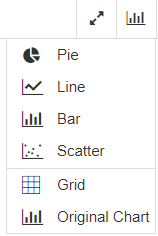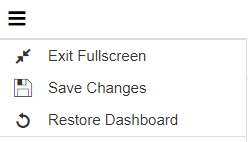Setting the output format of a stand-alone chart or report to AHTML provides In-Document Analytic capabilities at run-time. Content that uses In-Document Analytics provides users with an interactive interface that allows the generation of real-time, dynamic charts and reports. Its versatility not only allows you to interact with your content by adding filters, sorting data, and generating new content, but it also allows for offline content access. You can package a data set with a combination of analytical views, resulting in highly intuitive and interactive self-service business intelligence. This gives you an edge in presentation and analysis, making it easy to develop and share concepts, ideas, and scenarios. An interactive report is a self-contained report, meaning that it contains all the data and JavaScript® within the HTML output file. Packaging the data and the interactive functions in the HTML file also makes the output highly compressible for email and transparent to security systems. If you are working with a larger data set, you can also zip the output files to reduce the file size when sending them through email.
Note: You may need to zip interactive content output files to reduce the file size, and send them through your email client.
Your users can explore and interact with your data using various analytical tools such as sorting, filtering, calculations, roll-ups, and pivoting. They can also experiment with different scenarios using various options.
All of the interactive content that you create functions independently of a server, and is portable, making it easy for your users to work with and analyze complex data without requiring the use of an external application, such as Microsoft Excel. With two types of users (developer and end user), the roles in development and delivery of materials are clear. The end user interacts with the content that the developer creates and deploys. They can obtain content without any additional plug-ins or programs should they choose to access your content remotely or offline, independent of a server.
Note: Each artifact that you create at run time is given a unique number for easy identification. This number is incremental but not consecutive, and is assigned automatically.
When you run content using an AHTML output format, you can review and continue to develop it using the available menus. For example, when you run a chart, you can select the chart menu to change the type of chart you are showing, as shown in the following image.

To add a new chart or edit your content, you can use the options available from the vertical Ellipsis menu, which is shown in the following image.

When you view your report or chart at full screen, a hamburger menu also displays, as shown in the following image. From this menu, you can exit full screen, save changes, or restore the dashboard.

For more information on In-Document Analytics, see the In-Document Analytics User's Guide.